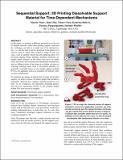| dc.contributor.author | Nisser, Martin | |
| dc.contributor.author | Zhu, Junyi | |
| dc.contributor.author | Chen, Tianye | |
| dc.contributor.author | Bulovic, Katarina M. | |
| dc.contributor.author | Punpongsanon, Parinya | |
| dc.contributor.author | Mueller, Stefanie | |
| dc.date.accessioned | 2019-07-09T16:52:32Z | |
| dc.date.available | 2019-07-09T16:52:32Z | |
| dc.date.issued | 2019-03 | |
| dc.identifier.isbn | 9781450361965 | |
| dc.identifier.uri | https://hdl.handle.net/1721.1/121542 | |
| dc.description.abstract | In this paper, we propose a different perspective on the use of support material: rather than printing support structures for overhangs, our idea is to make use of its transient nature, i.e. the fact that it can be dissolved when placed in a solvent, such as water. This enables a range of new use cases, such as quickly dissolving and replacing parts of a prototype during design iteration, printing temporary assembly labels directly on the object that leave no marks when dissolved, and creating time-dependent mechanisms, such as fading in parts of an image in a shadow art piece or releasing relaxing scents from a 3D printed structure sequentially overnight. Since we use regular support material (PVA), our approach works on consumer 3D printers without any modifications. To facilitate the design of objects that leverage dissolvable support, we built a custom 3D editor plugin that includes a simulation showing how support material dissolves over time. In our evaluation, our simulation predicted geometries that are statistically similar to the example shapes within 10% error across all samples. | en_US |
| dc.language.iso | en | |
| dc.publisher | ACM Press | en_US |
| dc.relation.isversionof | 10.1145/3294109.3295630 | en_US |
| dc.rights | Creative Commons Attribution-Noncommercial-Share Alike | en_US |
| dc.rights.uri | http://creativecommons.org/licenses/by-nc-sa/4.0/ | en_US |
| dc.source | MIT web domain | en_US |
| dc.title | Sequential Support: 3D Printing Dissolvable Support Material for Time-Dependent Mechanisms | en_US |
| dc.type | Article | en_US |
| dc.identifier.citation | Nisser, Martin, et al. “Sequential Support: 3D Printing Dissolvable Support Material for Time-Dependent Mechanisms.” Proceedings of the Thirteenth International Conference on Tangible, Embedded, and Embodied Interaction - TEI ’19, Tempe, Arizona, USA, 17-20 March, 2019, ACM Press, 2019, pp. 669–76. | en_US |
| dc.contributor.department | Massachusetts Institute of Technology. Computer Science and Artificial Intelligence Laboratory | en_US |
| dc.contributor.department | Massachusetts Institute of Technology. Department of Electrical Engineering and Computer Science | en_US |
| dc.relation.journal | Proceedings of the Thirteenth International Conference on Tangible, Embedded, and Embodied Interaction | en_US |
| dc.eprint.version | Author's final manuscript | en_US |
| dc.type.uri | http://purl.org/eprint/type/ConferencePaper | en_US |
| eprint.status | http://purl.org/eprint/status/NonPeerReviewed | en_US |
| dc.date.updated | 2019-06-28T13:26:57Z | |
| dspace.date.submission | 2019-06-28T13:26:59Z | |
